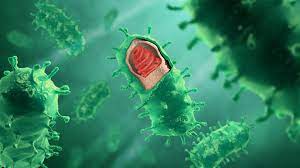Identifying Possible Rabies Symptoms in Your Pet
Rabies is a viral disease caused by the rabies virus, which poses a serious threat to both human and animal health. Recognized as a zoonotic disease, rabies is primarily transmitted through the bite of an infected animal, with mammals being the primary carriers. While vaccination efforts have significantly reduced the incidence of rabies, it remains crucial for pet owners to be vigilant in identifying potential symptoms in their animals. We will try to provide a comprehensive overview of possible rabies symptoms in pets, emphasizing the importance of early detection and prompt action. I hope that you will find this article helpful.


Rabies is a viral infection that has a profound impact on the central nervous system, causing a relentless and ultimately fatal condition known as encephalitis, which involves inflammation of the brain. The virus is primarily spread through the infected saliva of animals, often through bites. Once clinical symptoms become apparent, the outcome is overwhelmingly fatal, underscoring the critical importance of promptly identifying and addressing early signs of the disease. Recognizing potential rabies symptoms in pets is crucial for both their well-being and the safety of those around them. Behavioral changes such as increased aggression or agitation, excessive salivation, difficulty swallowing, and unprovoked aggression can be red flags. Progressive paralysis, unusual vocalizations, hiding, and disorientation are also signs to watch for. Swift identification of these symptoms enables timely intervention and precautionary measures to prevent the spread of this serious and potentially fatal disease.
What signs should you be vigilant about in your pet if you suspect it has been bitten by an animal that might carry rabies?
First, look for behavioral Changes. One of the key indicators of potential rabies infection in animals is the manifestation of significant behavioral changes. This can manifest as a departure from their usual demeanor and routine. For instance, pets that are typically calm and friendly may exhibit a startling surge in aggression, becoming unusually confrontational or even agitated without apparent reason. Restlessness and disorientation might become apparent, with pets appearing disconcerted or lost in their surroundings. Pets that once enjoyed human interaction might abruptly display signs of irritability, steering clear of the companionship they once sought. This withdrawal from social engagement can be a notable red flag. Watch for any shift in behavior and how pet interacts with their environment. Restlessness may manifest as pacing or repeatedly walking in circles. The overall departure from their regular temperament can be a clear indication that something is amiss and requires prompt attention. In the context of rabies, recognizing these shifts in behavior takes on a heightened significance. Do not assume your pet is simply having an off day; it is about potentially identifying the early stages of a serious illness. The behavioral deviations, although unsettling, offer a crucial window of opportunity for early intervention. By identifying these changes and acting promptly, pet owners can play a pivotal role in securing the health and safety of their animals and those around them.
People often come across another common symptom when encountering rabies – Excessive Salivation. To identify potential rabies symptoms in pets, one needs a keen understanding of how these symptoms physically present themselves. One clear indicator is when pets excessively salivate, a condition often colloquially referred to as “foaming at the mouth.” This visible sign often associates with rabies and can significantly contribute to indicating the presence of the disease.. Rabies affects the central nervous system, encompassing the muscles that handle swallowing. As the virus gains control, it can paralyze these muscles, resulting in challenges with swallowing. This paralysis of throat muscles results in a noticeable increase in drooling. Observing a pet with frothy saliva or even foam around its mouth can be deeply unsettling and demands attention. It is important to remember that not all instances of excessive drooling point to rabies; context matters significantly. If a pet is also displaying other behavioral changes and concurrently struggling with excessive salivation, there is substantial reason for concern. Swiftly seeking veterinary care in such situations becomes paramount. By identifying this classic symptom and taking prompt action, pet owners can potentially aid in the early diagnosis and management of rabies – a disease that requires immediate attention due to its severe and frequently fatal nature.
Observe for any difficulty swallowing. A key symptom that warrants careful observation in animals suspected of rabies infection is difficulty in swallowing. This seemingly simple physiological action can become an intricate struggle for pets affected by the virus. The disruption caused by the rabies virus to the central nervous system can extend to the muscles responsible for coordinating the act of swallowing, leading to noticeable abnormalities in this basic function. Pets grappling with rabies may exhibit unusual vocalizations, which can be distressing to witness. The discomfort caused by the paralysis of throat muscles may prompt them to make sounds that are out of character or even painful. Additionally, their efforts to swallow might become exaggerated and apparent, as if the act itself has become an arduous task. This struggle to perform a fundamental bodily function is a glaring indication that something is amiss. In the broader context of identifying possible rabies symptoms, difficulty in swallowing takes on a critical role. It serves as a piece of the puzzle, often existing alongside other signs such as behavioral changes or excessive salivation. Recognizing this aspect of the disease requires careful attention to your pet’s actions, sounds, and behaviors. Should you suspect any abnormality in your pet’s swallowing patterns, seeking veterinary care promptly is crucial. By doing so, you can contribute to the early detection and management of rabies, potentially preventing its progression and safeguarding your pet’s health.
Rabies infection is characterized by a hallmark progression of paralysis, originating in the hind limbs and gradually extending cephalad. This pathological manifestation arises due to the virus’s persistent assault on the central nervous system, which disrupts synaptic communication between neurons and muscular tissue. As a consequence of this disruption, there is a gradual deterioration of both mobility and physiological functionality. In its initial stages, this deterioration is reflected as hind limb weakness, resulting in compromised bipedal stance and ambulation in affected subjects. This initial weakness can rapidly evolve into a state of complete paralysis, precipitating the cessation of all movement within the affected limb extremities. Subsequently, this paralysis advances incrementally, exerting its influence on the musculature that governs fundamental physiological processes such as mastication and deglutition. Consequently, animals afflicted by rabies exhibit an escalating struggle in the consummation of sustenance and fluids, thereby contributing to an overall deterioration in their physiological homeostasis. The progression of this debilitating paralysis markedly compromises the afflicted animals’ quality of life, underscoring the exigency of its timely identification. Attentive caretakers must meticulously document any gradual decrement in locomotor capacity, aberrant locomotion patterns, or ultimate immobilization, prompting the imperative for immediate veterinary intervention. The prompt recognition and early therapeutic management of this progressive paralysis hold the potential to proffer ameliorative care, augmenting the subjects’ comfort and physiological equilibrium despite the relentless virulence of the infecting agent.
Unusual Noises or Vocalizations. Amid the spectrum of potential rabies symptoms in animals, an often overlooked yet significant indicator is the emergence of abnormal vocalizations. These sounds, which can range from peculiar growls to distressing whines, serve as a unique window into the changes taking place within an afflicted pet’s body. As the rabies virus infiltrates the central nervous system, it can disrupt the intricate harmony between nerves and muscles. This disruption may manifest as involuntary vocalizations that are unusual for the pet in question. Growls or other vocal expressions might occur in situations where they would not have been present before, indicating a dissonance between the pet’s internal state and their outward response. Unusual vocalizations stand as a testament to the virus’s far-reaching impact on the body. They underscore the need for vigilant observation, as these sounds may serve as an early sign of an underlying issue. Pets displaying such vocalizations, particularly in conjunction with other symptoms, warrant prompt veterinary assessment. By recognizing the significance of these auditory cues, pet owners can contribute to the early detection and management of rabies, potentially sparing their beloved companions from the more severe consequences of this grave viral infection.
Hiding. An often underestimated yet revealing indicator of rabies in animals involves a sudden proclivity to seek refuge in dim or secluded locales. This behavior, though seemingly inconspicuous, harbors profound implications that yield insightful understanding into the animal’s altered condition. Rabies, upon infiltrating the central nervous system, disrupts an animal’s conventional responsiveness to sensory stimuli, including light. Consequently, animals afflicted by the virus might exhibit an aversion to light and an augmented preference for shadowy, concealed areas. This deviation from their customary conduct is exemplified by their decision to seek solace in spaces affording minimal exposure to illumination and external triggers. This propensity for concealment frequently coincides with an evasion of interaction, encompassing both human and interspecies contact. Grasping the significance of hiding as a potential rabies symptom underscores the critical nature of vigilant observation. Pet guardians noting such conduct in their animals should recognize it as a notable warning sign. When coupled with other symptoms, hiding can point towards an underlying matter necessitating swift veterinary assessment. By attuning themselves to these behavioral shifts, pet proprietors assume a pivotal role in early-stage rabies identification, thereby facilitating timely intervention and potentially ameliorating the gravity of the disease’s impact.
Unprovoked Aggression. Within the range of potential symptoms, unprovoked aggression assumes a particularly concerning and significant role in indicating rabies in pets. This shift in behavior, marked by a sudden eruption of aggression lacking an evident cause, can deeply perplex and trouble pet owners. A pet that generally displays docility and good manners might suddenly demonstrate aggressive tendencies, evident through growling, snarling, or even biting. This unexpected deviation from their accustomed temperament is a noteworthy departure that should not be disregarded. It’s vital to acknowledge that this aggression may not be directed at any specific stimulus; rather, it seems to emerge unpredictably. This change in behavior underscores the profound influence of the rabies virus on the central nervous system, which can result in mood and behavior alterations. Detecting unprovoked aggression necessitates astute observation of shifts in your pet’s demeanor and interactions. Identifying and promptly addressing this symptom can serve as a pivotal measure in safeguarding both your pet’s well-being and the safety of those who come into contact with them.
Disorientation and Seizures. Rabies, a formidable viral infection affecting the central nervous system, can lead to a cascade of distressing symptoms in animals. One of these telltale signs is the onset of disorientation and seizures, which can be particularly distressing to witness. As the virus infiltrates the brain and disrupts normal neural communication, affected animals may experience bouts of confusion and disorientation. They might appear lost or disoriented even in familiar surroundings, displaying behaviors that deviate significantly from their usual actions. This state of confusion can be unsettling for both pets and their owners, underscoring the disease’s profound impact on their cognitive functions. In addition to disorientation, seizures can also become a part of the clinical picture in rabies-infected animals. These seizures, characterized by uncontrollable and often violent convulsions, stem from the virus’s assault on the nervous system. Seizures can vary in intensity and duration, adding to the distress experienced by both the animal and those who care for them. Understanding the significance of disorientation and seizures in the context of rabies underscores the urgency of early detection. By recognizing these symptoms and seeking prompt veterinary attention, pet owners can potentially contribute to the management and treatment of the disease. Disorientation and seizures serve as stark reminders of the need for vigilance and proactive care in safeguarding the well-being of animals, particularly in the face of a disease as grave and unforgiving as rabies.

The Importance of Immediate Action
Recognizing these symptoms is critical because rabies is invariably fatal once clinical signs appear. If you suspect your pet is displaying any of these symptoms, it is vital to take immediate action. Contact a veterinarian, and if your pet has bitten or scratched you, seek medical attention promptly. Quarantine or euthanasia might be required in some cases to prevent the spread of the virus.
Prevention and Vaccination
Preventing rabies in pets primarily involves adhering to vaccination schedules. Regular vaccination not only safeguards pets from rabies but also acts as a barrier against transmission to humans. Responsible pet ownership, including keeping pets indoors, minimizing contact with wildlife, and promptly vaccinating them, plays a crucial role in preventing rabies transmission.
Conclusion
In the realm of pet ownership, the ability to identify potential rabies symptoms becomes not just a responsibility, but also a lifeline for both your beloved companion and those around you. The gravity of rabies as a disease underscores the critical importance of vigilant observation and swift action. By remaining attuned to your pet’s behavior and any deviations from their normal state, you become the first line of defense against this deadly virus.
The urgency of early detection cannot be overstated. Rabies, once clinical signs become evident, is a relentless force that leaves no room for recovery. Thus, your role as a pet owner transforms into that of a guardian, equipped with the power to save lives through recognition and response. Whether it is behavioral changes, excessive salivation, paralysis, or any other potential symptom, your awareness and swift decisions can be the turning point in the trajectory of your pet’s health. Equally significant is the responsibility to protect not just your pet, but your family, community, and even yourself. Rabies is a zoonotic disease, and an infected pet can pose a direct risk to human health. By acting promptly and responsibly, you mitigate the potential for transmission and contribute to a safer environment for everyone. Remember, the journey of vigilance against rabies does not end with identification; it extends into prevention. Adhering to vaccination schedules, practicing responsible pet ownership, and minimizing interactions with wildlife are all integral components of a comprehensive approach to rabies prevention. In essence, your dedication to understanding and identifying possible rabies symptoms demonstrates the embodiment of the profound bond you share with your pet. Your watchfulness, care, and swift action speak to the commitment to safeguard their well-being. By embracing this role, you become a beacon of awareness and an advocate for both your pet’s health and the collective welfare of your community







